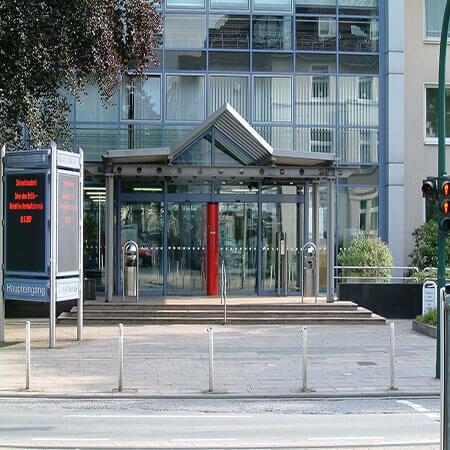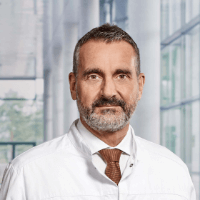Reconstruction Surgery for Patent Foramen Ovale (PFO) in Germany
Treatment prices are regulated by national law of the corresponding countries, but can also include additional hospital coefficients. In order to receive the individual cost calculation, please send us the request and medical records.

Department of Cardiothoracic Surgery
According to the Focus magazine, the Department of Cardiothoracic Surgery ranks among the top German medical facilities specializing in the surgical treatment of diseases of the cardiovascular system and lung cancer! The department offers the full range of surgical services for the treatment of diseases of the cardiovascular system, respiratory tract, including heart and lung transplantation, artificial heart implantation. The therapeutic options include aortic surgery, coronary artery bypass grafting, transplantation surgery, surgical treatment of heart rhythm disorders (arrhythmias), minimally invasive surgery, surgical treatment of the heart valves, including reconstructive interventions. All operations are performed using state-of-the-art technology and in accordance with the current recommendations of professional societies.






Department of Cardiac Surgery
The Department of Cardiac Surgery provides a full range of surgical treatment in its area of specialization. Special emphasis is placed on heart valve repair and replacement surgery, coronary artery bypass grafting, thoracic aortic surgery, adult congenital and acquired heart disease surgery, pacemaker and defibrillator implantation, and artificial heart implantation for severe heart failure. Many heart operations are performed using minimally invasive techniques, which has a positive effect on the healing of the surgical wound. Minimally invasive cardiac procedures also reduce surgical risks and contribute to a rapid recovery of the patient in the postoperative period. Surgical treatment of cardiac pathologies is performed in advanced operating rooms equipped with the latest technology. The cardiac surgeons of the department successfully perform routine and complex surgical procedures, saving the lives of thousands of patients. The specialists work in accordance with current clinical protocols and follow the recommendations of the German Society for Thoracic and Cardiovascular Surgery (DGTHG).


Department of Cardiothoracic Surgery and Vascular Surgery
The Department of Cardiothoracic Surgery and Vascular Surgery provides effective surgical treatment for diseases of the heart, respiratory system, and blood vessels. The team of cardiac surgeons operates on patients with heart valve pathologies, coronary heart disease, heart failure, and heart rhythm disturbances. In the field of thoracic surgery, the key focus is on the surgical removal of lung tumors and lung metastases. The specialists in this area also perform surgery to repair chest wall deformities. In the field of vascular surgery, interventions for abdominal and thoracic aortic aneurysms are most often performed here. The department's vascular surgeons are also exceptionally competent in the treatment of peripheral occlusive arterial disease. A great advantage for the department's patients is that almost all surgical interventions are performed using minimally invasive techniques, so there is no need for a long postoperative recovery. The department's operating rooms are equipped with state-of-the-art technology. This allows for effective and safe treatment. The priority is always personalized medical care for patients.






A patent foramen ovale (PFO) is a common heart anomaly that is not considered a defect. It occurs in about 25% of the population and usually does not affect health due to its small size. A large foramen ovale, however, is dangerous. Thrombi may penetrate from the venous half of the heart into the arterial half. From there, they can enter the cerebral vessels and cause a stroke. The large patent foramen ovale, therefore, requires treatment even if a patient has no symptoms. If you have this heart anomaly, you can get help at one of the German hospitals. You are welcome to use the Booking Health website to find out the cost of treatment in Germany and choose a medical care program at the best price.
Content
- What is a foramen ovale?
- Indications for the treatment of a patent foramen ovale
- Who may need surgery for a patent foramen ovale?
- How is surgery for a patent foramen ovale performed?
- Where to get treatment services for your patent foramen ovale?
What is a foramen ovale?
A foramen ovale is an opening between the two atria that functions during fetal development. After the birth of a child, it becomes unnecessary and closes within a few months.
This happens to 75% of people. However, in about 25% of children, the foramen ovale remains open. This does not affect health in any way and does not cause any symptoms, so the fact that the foramen ovale has not closed can rarely be detected immediately. It is usually an incidental finding in adults during diagnostics for other diseases.
The size of the patent foramen ovale usually ranges from 1 to 19 mm. It increases over time. The average size is 4.5 mm.
The patent foramen ovale is usually diagnosed after a stroke. Contrast-enhanced echocardiography is used to detect it. This examination allows doctors to assess in which direction and how intensively blood is discharged through the foramen ovale from the right half of the heart to the left. A contrast agent is administered intravenously. Transthoracic (through the chest wall) echocardiography is then performed. Doctors do a clear test and an ultrasound scan with the Valsalva maneuver (before the contrast is injected, a patient takes a deep breath, straining and exhaling).
Indications for the treatment of a patent foramen ovale
In most patients, a patent foramen ovale does not affect health. A little amount of blood is discharged from the venous part of the heart into the arterial part, but hemodynamics is not impaired.
The main problem with the patent foramen ovale is the high risk of stroke. If a stroke occurs at a young age, in half of the cases, doctors detect the patent foramen ovale in the patient during diagnostics.
In addition, this cardiac anomaly causes migraine attacks. It affects 50% of patients, and often the headache is accompanied by neurological symptoms. There are two causes of migraine:
- Serotonin and other substances pass from the right atrium to the left, avoiding metabolic transformation in the lungs. They enter the systemic circulation faster and in higher concentrations, and when they reach the brain, they can stimulate receptors in susceptible people.
- Microemboli can pass through the patent foramen ovale, causing oxygen deprivation in tissues and irritating the cerebral cortex, leading to migraine and depression.
Despite the fact that the patent foramen ovale has a negative impact on health in some people, the mere detection of it does not warrant the necessity for treatment. Even after a stroke, treatment is not always required. Treatment may be conducted in the following cases:
- a stroke before the age of 60;
- a stroke after the age of 60, if it is definitely established that the cause of the stroke was the patent foramen ovale;
- a previous stroke in combination with atrial fibrillation or venous thromboembolism;
- systemic thromboembolism (without stroke);
- platypnea syndrome is when a patient has shortness of breath in a standing position and, at the same time, other causes of it are excluded, with the exception of the patent foramen ovale.
Who may need surgery for a patent foramen ovale?
Surgical reconstruction for a patent foramen ovale is rarely performed.
In most patients, the patent foramen ovale is not treated at all. If there is an indication for its closure, doctors use minimally invasive techniques, such as the Cardioseal Septal system or the amp Later PFO occluder, to close the foramen ovale through an endovascular approach. Manipulations are carried out from the inside of the blood vessels. A small incision in the groin area is sufficient to deliver the device to the heart and place it in the area of an atrial septal defect.
Surgical closure of the patent foramen ovale is required only when two conditions are combined:
- indications for the treatment of the patent foramen ovale;
- the impossibility of endovascular treatment.
The reasons why the patent foramen ovale cannot be closed using an endovascular technique may be different. For example, the procedure is not technically available because it is not available at the hospital due to a lack of equipment or specialists. Perhaps an endovascular intervention is technically impossible to perform because:
- the diameter of the patent foramen ovale is too large, exceeding 2.5 cm;
- there is too little normal tissue left in the septum of the heart on one of the edges, so it is impossible to securely fix the occluder;
- the septum of the heart is deformed.
In addition, after an endovascular procedure, long-term use of anticoagulants is required, at least for six months. For some patients, they are contraindicated due to the risk of severe bleeding. In such a case, doctors may opt for surgery, since after surgical reconstruction, anticoagulants are used for only a few days.
In some patients, the patent foramen ovale is accompanied by other heart defects. If they require open-heart surgery, the foramen ovale can be closed simultaneously.
How is surgery for a patent foramen ovale performed?
Surgery is performed using open surgical techniques under general anesthesia. The heart is approached through a chest incision. A patient is connected to a heart-lung machine. The device performs the functions of the heart and lungs, while doctors perform the necessary manipulations on the patient's temporarily stopped heart.
When performing the operation, doctors dissect the chest and right atrium, after which a patch is placed on the defect site. The patch may consist of the patient's own pericardium or artificial materials. If necessary, comorbidities can be eliminated as well.
After surgery, the patient's symptoms disappear, for example, migraine attacks or shortness of breath, which are typical of a large foramen ovale. The risk of stroke is reduced to the average in the population. The prevention of stroke is one of the main goals of the treatment of the disease.
Where to get treatment services for your patent foramen ovale?
If you need services to close your foramen ovale, you can undergo treatment in Germany. Healthcare facilities in this country offer top-class medical services. Treatment at German hospitals has the following benefits:
- doctors have state-of-the-art equipment;
- a high level of medical training for cardiac surgeons;
- reliable results of the surgical intervention and freedom from revision surgery;
- treatment that is safe for your health: the frequency of complications at German hospitals is several times lower than the world average;
- high-quality postoperative care, symptomatic therapy, comprehensive rehabilitation, and comfortable conditions at German hospitals.
You are welcome to use the Booking Health website, where you can find out the cost of treatment in Germany and compare prices at different German hospitals. You can also make an appointment for your treatment in Germany through Booking Health. When receiving medical services through Booking Health, the cost of treatment in Germany will be lower for you than when you contact a German hospital directly. The price for services is reduced due to the absence of high taxes for foreign patients. The initial cost of treatment in Germany will not increase for you, even if additional medical services are required, because you will receive insurance that will cover unforeseen medical expenses.
The medical tourism agency Booking Health will provide you with services for organizing your treatment in Germany, while you can fully concentrate on the restoration of your health. We will contact the hospital and schedule an appointment for your preferred dates. We will also book the nearest hotel to the hospital, buy airline tickets, and translate your medical records into German. Our company's specialists will meet you at the German airport and take you to the hospital by car. After the completion of your treatment in Germany, we will take care of your return transfer.
Authors:
The article was edited by medical experts, board-certified doctors Dr. Nadezhda Ivanisova and Dr. Vadim Zhiliuk. For the treatment of the conditions referred to in the article, you must consult a doctor; the information in the article is not intended for self-medication!
Sources:
European Society of Cardiology

